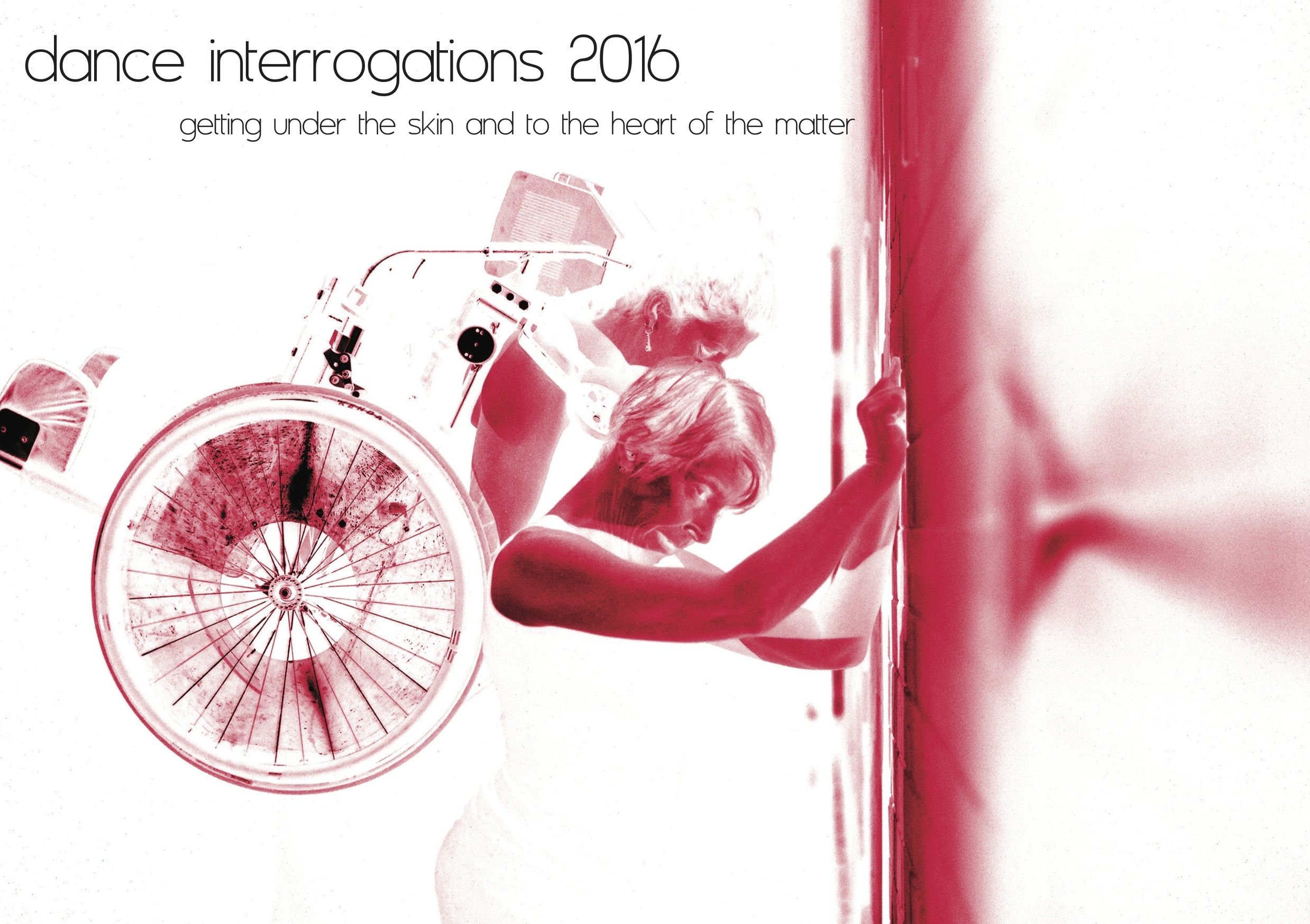Dance Interrogations 2016: In Contemplation of Fragility and Strength
What is our relationship to the inevitable fallibility of our body? What kind of support will we accept from technologies and from others? Through the lens of a stark and tender portrait of partnership, Dance interrogations 2016 examines our vulnerabilities and resilience. It is a duet between the gently insistent and fragile Smith and the fierce and wry Reid, but it is ghosted with the presence of others on screen, and objects which take on persona’s. The artists describe it as a graphic installation: proposing that this account for the visual art elements, however it is most graphic in its striking, powerful and explicit negotiations of relationship, support, empathy, and partnership.
Bleeding through from the everyday to performance, a woman, like those we may have seen lost on the street, a quixotic Reid swaddled in a thick coat, appears outside the entrance to FCAC. She dances the foyer, animating and eliminating our polite distances from each other: our social etiquette is smashed. She lingers with a head on a guests’ knee, shoulder. She catches edges of one conversation and repeats them almost to herself, or to another group, pollinating the audiences’ expectations and energy. Insisting through the force of her presence that we share one another, be intimate with one another and the space.
Once invited into the theatre, we navigate our way to our chairs through the topography of the installation: it is dominated by scaffolding of wheelchairs, lying like refuse, all right angles and circles throughout the space. We meet Smith as she crawls out from under Reid’s discarded coat, shedding it like a chrysalis. There are multiple screens showing a profusion of images – landscapes, bodies, texts, sped up with frequent cuts – and I feel like I’m on high speed. To begin with I’m at sea with all of these images, then I surrender to this and they slowly begin to have relationship. One image on the floor in the shape of a circle, becomes mirrored by another circle of light and I confront the wheelchair as spectre.
These two spots pin the dancers. Reid performs a playful, sometimes brutal, duo with a wheelchair. She endows it with her gaze and her presence and it becomes almost animate, almost responsive. The chair grows long white fabric arms and Reid is sometimes embraced, sometimes repelled or trapped by these arms. Smith, in the downstage spot, performs a duet with an actual wheel from a chair, as though it is the ship wheel that she steers by. A projected text announces unravelling riddles of neurons, and I am thinking of mirror neurons, and how Smith’s body finds itself mirrored by Reid. They sum each other up, they sum up their own selves as they are in relation to one another.
At one point the pair are framed by a screen. A crisp film of the duo and the wheelchair plays behind them. It is as through the film is a shadow of them. They dance in relation to this film and to the wheelchair. Each of them is doubled and they partner themselves in the film – it is a quadruplet dance. In the fissure between actual and screen bodies all of the hesitations, and desires, and regrets, that a body has, are revealed.
There is a mordant humour buried in the work. It reveals itself when the technology of Siri is employed to speak poetic musings on bodies. A deeply intimate monologue to her wheelchair written by Smith, is spoken with Siri’s depersonalised, clinical, but highly proper pronunciation and tone.
Reid performs an elegiac monologue on all-that-has-been-and-all-that-will-come, and her body becomes palimpsest for images. We are seduced into a hypnosis by lush images projected on Reid’s body, and lush words spoken, when all of a sudden Reid rips a door open beside her. The projected images are ambushed by the external light and the starkness of corridor. Reid exits.
We return to the foyer to find Smith is suspended by a harness. It seems it costs Smith to do this work, whereas Reid appears effortless in her embodiment of gestures. Reid takes off one of the clips from the harness and attaches it to herself, becoming the anchor for Smith. The moment Reid takes Smith’s weight completely, the power of completely countering the weight, ricochets between them, sending an impulse out into Reid that sends her into tiny footsteps orbiting around Smith’s suspended body. The lights are on full, we are all part of this final partnering, in empathy with the dancers, in contemplation of the fragility and strength found in partnership.
Dance Interrogations 2016 is ultimately an examination of the negotiations of relationship, and the expectations, desires, and respite that are therein found. From the tender brush of a gaze, to the flick of a tiny rejection, to the balancing of caretaking, we are all dancing in our relationships. Smith and Reid are experts at it.
